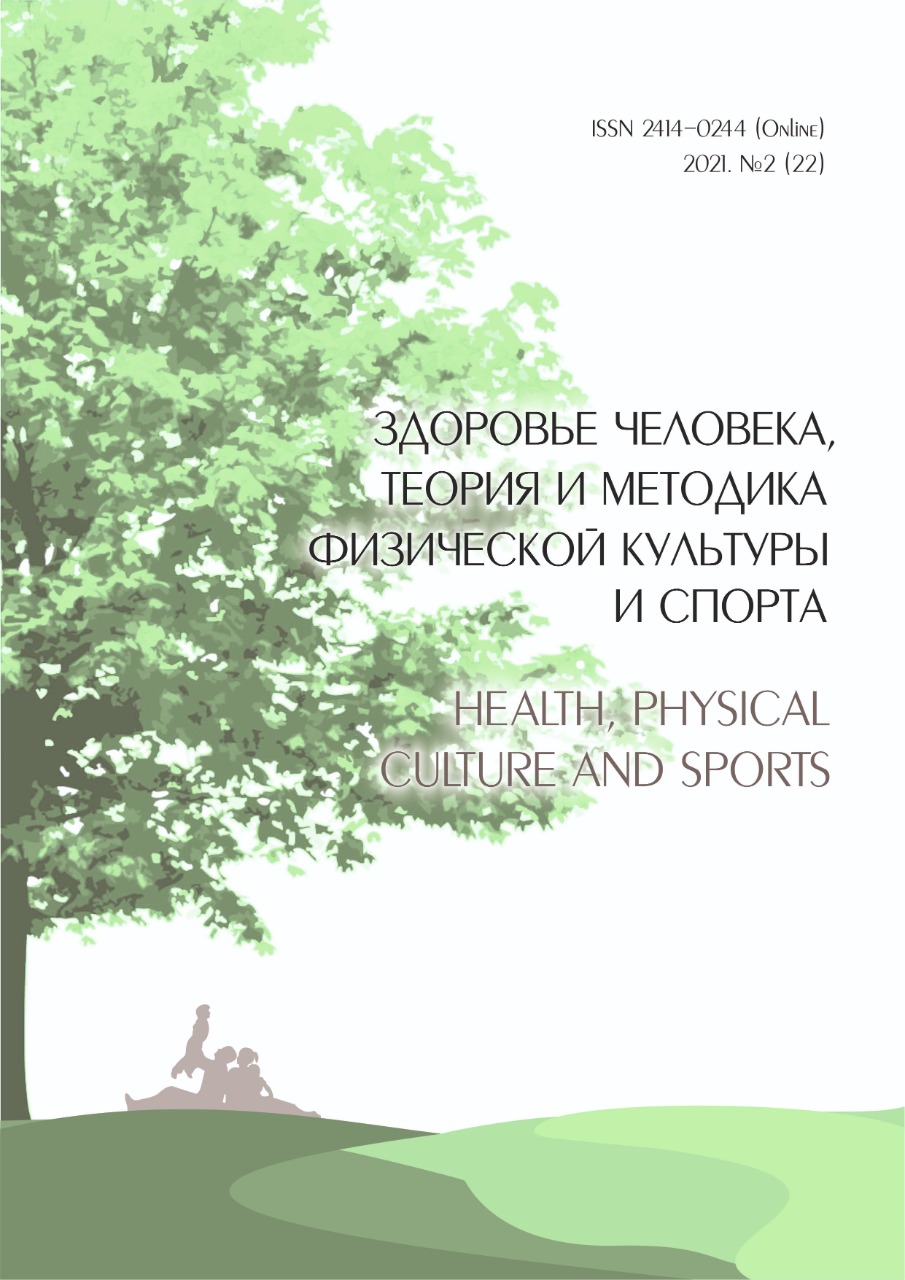FEATURES OF THE STATE OF HEMODYNAMICS OF STUDENTS DEPENDING ON THE AVAILABILITY OF SPORTS TRAINING
Abstract
The purpose of the study in this article was to study the state of the hemodynamic parameters of students, depending on the presence or absence of sports training. The study included the results of a cardiointervalographic study of 102 students (age 19–20 years), differentiated into students who regularly engage in physical activity and students who have virtually no physical activity. For ECG registration and analysis of hemodynamic parameters, including those characterizing heart rate variability, the sports testing system "Medical Soft" (variant "MS FIT Pro", Russia) was used. Standard hemodynamic parameters (blood pressure level, pulse rate, stroke volume, cardiac output, etc.), statistical and spectral indicators of heart rate variability, as well as an integral criterion of the state of microcirculation were used for monitoring. The data analysis was performed in accordance with the age standards formed by the equipment developers. The study allowed us to establish that the studied hemodynamic indicators and parameters of heart rate variability in the majority of student-athletes generally fit within the physiological age range. The trained group of individuals had a lower level of heart rate, a lower risk of arrhythmogenic events, increased sympathetic stimulation of the myocardium, a larger volume of blood vessels and arteriole tone. Consequently, students engaged in physical exercises have greater adaptive reserves and better training of the myocardium.
Downloads
References
2. Бочарин И.В., Мартусевич А.К., Гурьянов М.С., Киселев Я.В., Канатьев К.Н., Полебенцев С.Н. Результаты скринингового обследования состояния сердечно-сосудистой системы студенческой молодежи г. Нижнего Новгорода. International Journal of Medicine and Psychology 2020; 3(1): 118–121.
3. Ноздрачев А.Д, Щербатых Ю.В. Современные способы оценки функционального состояния автономной (вегетативной) нервной системы. Физиология человека 2001; 27(6): 95–101.
4. Котельников С.А. с соавт. Вариабельность ритма сердца: представления о механизмах. Физиология человека 2001; 28(1): 130–143.
5. Остроумова О.Д. с соавт. Спектральный анализ колебаний частоты сердечных сокращений у больных эссенциальной артериальной гипертензией. Российский кардиологический журнал 2000; 26(6): 64–71.
6. Перетягин С.П., Мартусевич А.К., Борисов В.И. Исследование особенностей вариабельности сердечного ритма у пациентов с ожогами. Вестник анестезиологии и реаниматологии 2011; 8(4): 10–14.
7. Мартусевич А.К., Жукова Н.Э. Вариабельность сердечного ритма в динамике купирования алкогольного абстинентного синдрома. Вопросы наркологии 2011; 4: 11–16.
8. Першина Т.А., Спицин А.П. Особенности гемодинамики у студенток с наследственной отягощенностью по артериальной гипертензии в условиях экзаменационного стресса. Гигиена и санитария 2013; 3: 80–85.
9. Britton D.M., Kavanagh E.J., Polman R.C. (2019). Validating a self-report measure of student athletes' perceived stress reactivity: associations with heart-rate variability and stress appraisals. J. Front Psychol. 10: 1083. DOI: 10.3389/fpsyg.2019.01083.
10. Misigoj-Durakovic M., Durakovic Z., Prskalo I. (2016). Heart rate-corrected QT and JT intervals in electrocardiograms in physically fit students and student athletes. Ann. Noninvasive Electrocardiol. 21(6): 595–603. DOI: 10.1111/anec.12374.
11. Boettger S., Puta C., Yeragani V.K., Donath L., Müller H.J., Gabriel H.H., Bär K.J. (2010). Heart rate variability, QT variability, and electrodermal activity during exercise. Med. Sci. Sports Exerc. 42(3): 443–448. DOI: 10.1249/MSS.0b013e3181b64db1.
12. Hulka O.V. (2015). Dynamics of spectral indexes of heart variability rate of the students with different character of the educational loading. Fiziol. Zh. 61(4): 98–104. DOI: 10.15407/fz61.04.098.
13. Pichon A, Nuissier F, Chapelot D. (2010). Heart rate variability and depressed mood in physical education students: a longitudinal study. Auton Neurosci. 156(1–2): 117–23. DOI: 10.1016/j.autneu.2010.03.019.
14. Redondo B., Vera J., Luque-Casado A., García-Ramos A., Jiménez R. (2019). Associations between accommodative dynamics, heart rate variability and behavioural performance during sustained attention: A test-retest study. Vision Res. 163: 24–32. DOI: 10.1016/j.visres.2019.07.001.
15. Sztajzel J. (2004). Heart rate variability: a noninvasive electrocardiographic method to measure the autonomic nervous system. Swiss med wkly. 134: 514–522.
16. Wang X., Yan C., Shi B., Liu C., Karmakar C., Li P. (2018). Does the temporal asymmetry of short-term heart rate variability change during regular walking? A pilot study of healthy young subjects. Comput. Math. Methods Med. 2018: 3543048. DOI: 10.1155/2018/3543048.
17. Drezner J.A., Peterson D.F., Siebert D.M., Thomas L.C., Lopez-Anderson M., Suchsland M.Z., Harmon K.G., Kucera K.L. (2019). Survival After Exercise-Related Sudden Cardiac Arrest in Young Athletes: Can We Do Better? Sports Health. 11(1): 91–98. DOI: 10.1177/1941738118799084.
18. Perkins S.E., Jelinek H.F., Al-Aubaidy H.A., de Jong B. (2017). Immediate and long term effects of endurance and high intensity interval exercise on linear and nonlinear heart rate variability. J. Sci. Med. Sport. 20(3): 312–316. DOI: 10.1016/j.jsams.2016.08.009.
19. Sharashdze N.S., Pagava Z.T., Saatashvili G.A., Agladze R.A. (2008). Heart rhythm abnormalities in middle-aged veteran elite athletes. Georgian Med News. (159): 31–34.
20. Adams J.A., Patel S., Lopez J.R., Sackner M.A. (2018). The Effects of passive simulated jogging on short-term heart rate variability in a heterogeneous group of human subjects. J. Sports Med. 4340925. DOI: 10.1155/2018/4340925.
Copyright (c) 2021 Health, physical culture and sports

This work is licensed under a Creative Commons Attribution-NonCommercial 4.0 International License.
An author should not normally publish manuscripts describing essentially the same research in multiple journals or publication venues. Such redundant publication is generally considered to constitute unethical publishing behavior, and if discovered may result in a manuscript under consideration being rejected, or a published article being retracted.
Authors of manuscripts reporting on original research should present an accurate account of the work performed, accompanied by an objective discussion of its significance. Underlying data should be represented accurately in the manuscript. The manuscript should contain sufficient detail and references to permit others to replicate the work. The fabrication of results and the making of fraudulent or knowingly inaccurate statements constitute unethical behavior and may be cause for rejection or retraction of a manuscript or published article.





